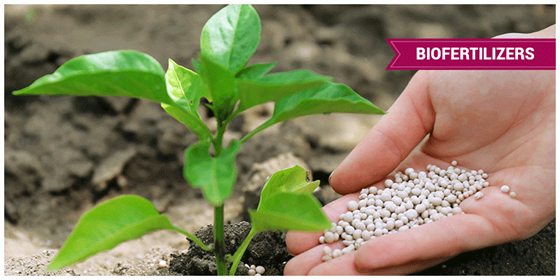Biofertilizers Definition
“Biofertilizers are substances that contain microorganisms, which when added to the soil increase its fertility and promotes plant growth.”

What is Biofertilizer?
Biofertilizers are substance that contains microbes, which helps in promoting the growth of plants and trees by increasing the supply of essential nutrients to the plants. It comprises living organisms which include mycorrhizal fungi, blue-green algae, and bacteria. Mycorrhizal fungi preferentially withdraw minerals from organic matter for the plant whereas cyanobacteria are characterized by the property of nitrogen fixation.
Nitrogen fixation is defined as a process of converting di-nitrogen molecules into ammonia. For instance, some bacteria convert nitrogen to ammonia. As a result, nitrogen becomes available for plants.
Also, read Nitrogen Fixation and Nitrogen Metabolism
Types of Biofertilizers
Following are the important types of biofertilizers:
Symbiotic Nitrogen-Fixing Bacteria
Rhizobium is one of the vital symbiotic nitrogen-fixing bacteria. Here bacteria seek shelter and obtain food from plants. In return, they help by providing fixed nitrogen to the plants.
Loose Association of Nitrogen-Fixing Bacteria
Azospirillum is a nitrogen-fixing bacteria that live around the roots of higher plants but do not develop an intimate relationship with plants. It is often termed as rhizosphere association as these bacteria collect plant exudate and the same is used as food by them. This process is termed associative mutualism.
Symbiotic Nitrogen-Fixing Cyanobacteria
Blue-Green algae or Cyanobacteria from the symbiotic association with several plants. Liverworts, cycad roots, fern, and lichens are some of the Nitrogen-fixing cyanobacteria. Anabaena is found at the leaf cavities of the fern. It is responsible for nitrogen fixation. The fern plants decay and release the same for utilization of the rice plants. Azolla pinnate is a fern that resides in rice fields but they do not regulate the growth of the plant.
Free-Living Nitrogen-Fixing Bacteria
They are free-living soil bacteria that perform nitrogen fixation. They are saprotrophic anaerobes such as Clostridium beijerinckii, Azotobacter, etc.
Among all the types of biofertilizers, Rhizobium and Azospirillum are most widely used.
Components of Biofertilizers
The components of biofertilizers include:
Bio Compost
It is one of the eco-friendly product composed of waste material released from sugar industries which are decomposed. It is magnified with human-friendly bacteria, fungi, and various plants.
Tricho-Card
It is an eco-friendly and nonpathogenic product used in a variety of crops as well as in horticultural and ornamental plants, such as paddy apple, sugar cane, brinjal, corn, cotton, vegetables, citrus, etc. It acts as a productive destroyer and antagonistic hyper parasitic against eggs of several bores, shoot, fruit, leaves, flower eaters and other pathogens in the field.
Azotobacter
It protects the roots from pathogens present in the soil and plays a crucial role in fixing atmospheric nitrogen. Nitrogen is a very important nutrient for the plant and about 78% of the total atmosphere comprises nitrogen.
Phosphorus
Phosphorus is one of the essential nutrients for plants growth and development. Phosphate solubilizing microorganisms, hydrolyze insoluble phosphorus compounds to the soluble form for uptake by plants. Many fungi and bacteria are used for the purpose such as Penicillium, Aspergillus, Bacillus, Pseudomonas, etc.
Vermicompost
It is an Eco-friendly organic fertilizer that comprises vitamins, hormones, organic carbon, sulfur, antibiotics that help to increase the quantity and quality of yield. Vermicompost is one of the quick fixes to improve the fertility of the soil.
Also refer: Vermicomposting
Importance of Biofertilizers
Biofertilizers are important for the following reasons:
- Biofertilizers improve the soil texture and yield of plants.
- They do not allow pathogens to flourish.
- They are eco-friendly and cost-effective.
- Biofertilizers protect the environment from pollutants since they are natural fertilizers.
- They destroy many harmful substances present in the soil that can cause plant diseases.
- Biofertilizers are proved to be effective even under semi-arid conditions.
Applications of Biofertilizers
Following are the important applications of biofertilizers:
Seedling root dip
This method is applicable to rice crops. The seedlings are planted in the bed of water for 8-10 hours.
Seed Treatment
The seeds are dipped in a mixture of nitrogen and phosphorus fertilizers. These seeds are then dried and sown as soon as possible.
Soil Treatment
The biofertilizers along with the compost fertilizers are mixed and kept for one night. This mixture is then spread on the soil where the seeds have to be sown.
Discover more about what is biofertilizer, types of biofertilizers and applications of biofertilizers, only at BYJU’S Biology
Frequently Asked Questions on Biofertilizers
What do you understand by biofertilizers?
Biofertilizers are substances that contain microorganisms, which when added to the soil increase the crop yield and promotes plant growth.
What are the advantages of biofertilizers over chemical fertilizers?
- Biofertilizers are cost-effective.
- They reduce the risk of plant diseases.
- The health of the people consuming the vegetables grown by the addition of chemical fertilizers is more at risk.
- Biofertilizers do not cause any type of pollution.
What is the need for using biofertilizers?
Biofertilizers are required to restore the fertility of the soil. Prolonged use of chemical fertilizers degrades the soil and affects crop yield. Biofertilizers, on the other hand, enhance the water holding capacity of the soil and add essential nutrients such as nitrogen, vitamins and proteins to the soil. They are the natural form of fertilizers and hence, widely used in agriculture.
Name a few microorganisms used as biofertilizers.
Microorganisms used as biofertilizers are:
- Rhizobium
- Azotobacter
- Azospirilium
How do biofertilizers promote plant growth?
What are the main sources of biofertilizers?
Name an important nitrogen-fixing bacteria.

clearly explained
your biology content is very good.
Bacillus spp. also bacteria, which when added to soil increased plant growth and yield.
So Bacillus sp. also a biofertilizer?
Thank you very much